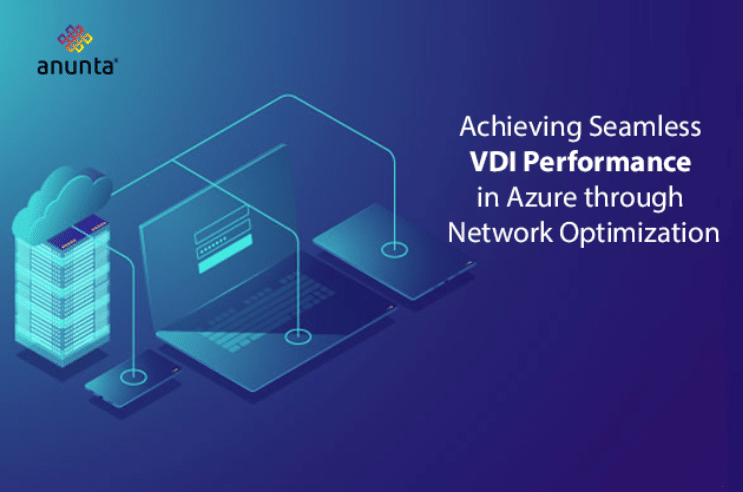
As more companies embrace Azure for Virtual Desktop Infrastructure (VDI), the question of network performance becomes crucial. A poor network can lead to slow logins, lagging applications, and dissatisfied users. But what if you could optimize network performance to deliver a seamless experience for everyone? In this blog, we’ll explore tips and strategies for enhancing VDI performance on Azure, ensuring your team stays productive and frustration-free.
Understanding the primary factors that impact VDI performance is essential to ensure a smooth and responsive user experience. Let’s explore the main elements that influence VDI network performance.
Latency measures the time it takes for data to travel between two points. High latency can cause sluggish performance in VDI environments, frustrating users. For example, when latency increases, even simple actions like typing or opening applications can be delayed, hampering productivity.
Adequate bandwidth is vital for VDI to function smoothly. More bandwidth can lead to degraded video quality, slow application performance, and disconnections. The demand for bandwidth grows when multiple users access resource-intensive applications.
Packet loss occurs when data packets fail to reach their destination, causing issues like incomplete screen displays or failed data transfers. Minimizing packet loss is essential for delivering a reliable VDI experience.
Heavy traffic on the network can create bottlenecks, slowing down performance. During peak usage times, congestion can significantly degrade VDI responsiveness, especially for users accessing large files or media-rich applications.
The performance of the applications running within the virtual desktop also affects the overall experience. Poorly optimized applications can drain network resources, resulting in delays and disruptions.
A well-planned approach is vital to ensure that VDI in Azure operates efficiently. Below are effective strategies for optimizing network performance.
Optimizing the design of your network is fundamental to improving performance. Selecting the right topology for your VDI environment, such as hub-and-spoke or mesh, can enhance routing efficiency and reduce latency.
Properly configured network routing ensures that data flows smoothly, while load balancing distributes traffic evenly across the network to prevent congestion.
Having the right hardware is crucial. Investing in high-quality network devices, including routers, switches, and firewalls, ensures adequate throughput and reduces bottlenecks. Additionally, it’s important to regularly assess network capacity to prevent it from being overwhelmed during high-demand periods.
Implementing Quality of Service (QoS) settings can prioritize VDI traffic, ensuring smooth performance even when the network is under strain.
Azure offers several tools and features that help optimize VDI network performance. For instance, Azure ExpressRoute provides a dedicated, high-bandwidth connection between on-premises infrastructure and Azure, reducing latency and improving reliability.
Azure’s intelligent network services can also help dynamically allocate resources based on usage.
By adopting continuous monitoring and network optimization techniques, organizations can sustain long-term VDI performance at high levels.
Tracking network performance regularly is essential to identifying issues before they become critical. Using network monitoring tools to analyze latency, bandwidth usage, and packet loss can help pinpoint areas for improvement. Continuous analysis ensures that any performance bottlenecks are addressed promptly.
Optimizing network configurations, such as tweaking TCP settings, can reduce latency and packet loss, leading to a more responsive VDI experience. Minimizing delays in application loading times also contributes to improved overall performance.
Conducting regular tests to evaluate the user experience is an invaluable step in network optimization. User feedback, combined with technical testing, helps identify and resolve performance issues that might take time to become apparent from a purely technical perspective.
Optimizing network performance in VDI environments hosted on Azure involves balancing multiple factors such as latency, bandwidth, congestion, and more. By carefully designing the network architecture, leveraging Azure’s capabilities, and continually monitoring performance, organizations can enhance the user experience and ensure that their VDI deployments deliver smooth and efficient service.
Applying these best practices will not only improve user satisfaction but also maximize the potential of VDI in modern workplaces.
Q: How does network latency affect VDI performance in Azure?
A: Network latency is the time it takes for data to travel between two points, such as from a user’s device to the Azure VDI environment. High latency can cause delays in actions like typing, opening applications, or navigating within the virtual desktop.
This sluggish performance can frustrate users and significantly reduce productivity.
Q: What role does bandwidth play in VDI performance, and how can it be optimized?
A: Bandwidth refers to the capacity of a network to handle data transmission. If the bandwidth is sufficient, users may experience faster application performance, better video quality, and disconnections.
As the number of users and the complexity of applications increase, more bandwidth is required. Optimizing bandwidth can involve increasing network capacity, load balancing, and prioritizing VDI traffic with Quality of Service (QoS) settings to ensure smoother performance.
Q: How does Azure help reduce network congestion for VDI environments?
A: Azure offers advanced capabilities like Azure ExpressRoute, which provides a dedicated, high-bandwidth connection between an organization’s infrastructure and the Azure cloud.
Q: What strategies can be used to prevent packet loss in a VDI setup on Azure?
A: Packet loss occurs when data packets fail to reach their destination, which can result in incomplete screen displays or failed data transfers. Strategies to minimize packet loss include optimizing network architecture, such as using hub-and-spoke or mesh topologies and implementing robust network hardware (routers, switches).
Q: How can organizations maintain long-term VDI performance in Azure?
A: Maintaining high VDI performance in Azure requires proactive monitoring and network optimization. Organizations should use network monitoring tools to track performance metrics like latency, bandwidth, and packet loss, allowing for early identification of potential issues.
Research Review with Anunta’s CTO | Jan 14 | 12PM PST/3PM EST